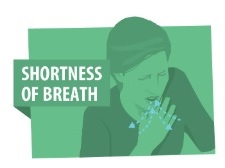Shortness of Breath
Shortness of breath (SOB), also medically known as dyspnea (AmE) or dyspnoea (BrE), is an uncomfortable feeling of not being able to breathe well enough. Defined by the American Thoracic Society as "a subjective experience of breathing discomfort that consists of qualitatively distinct sensations that vary in intensity," dyspnea is evaluated based on the intensity of sensations, the degree of distress, and its impact on daily activities. It can manifest as effort/work to breathe, chest tightness or pain, and "air hunger."

Causes
Dyspnea is commonly caused by disorders of the cardiac or respiratory systems but can also result from issues in the neurological, musculoskeletal, endocrine, hematologic, and psychiatric systems. Common cardiovascular causes include myocardial infarction and heart failure, while pulmonary causes include chronic obstructive pulmonary disease (COPD), asthma, pneumothorax, pulmonary oedema, and pneumonia. The pathophysiological basis divides causes into increased awareness of normal breathing, increased work of breathing, and abnormalities in the respiratory system. Neurological causes include strokes, tumours, infections, and traumas at the brain stem.
Common Conditions Associated with Dyspnea
Acute Coronary Syndrome: Presents with chest discomfort and difficulty breathing. Diagnosis involves ECG and cardiac enzymes.
COVID-19: Symptoms include fever, dry cough, loss of smell and taste, and in severe cases, shortness of breath.
Congestive Heart Failure: Presents with exertional dyspnea, orthopnea, and paroxysmal nocturnal dyspnea. Risk factors include high salt intake, medication noncompliance, and infections.
Chronic Obstructive Pulmonary Disease (COPD): Chronic shortness of breath and productive cough. Acute exacerbations require anticholinergics, beta2-adrenoceptor agonists, steroids, and possibly positive pressure ventilation.
Asthma: Commonly presents with shortness of breath, wheezing, and chest tightness. Acute symptoms are treated with short-acting bronchodilators.
Pneumothorax: Acute onset of pleuritic chest pain and shortness of breath not improved with oxygen. Physical findings include absent breath sounds on one side.
Pneumonia: Symptoms include fever, productive cough, and inspiratory crackles. Treated with antibiotics.
Pulmonary Embolism: Acute onset of shortness of breath with pleuritic chest pain and cough. Diagnosis may involve Wells Score and treatment starts with anticoagulants.
Anaemia: Gradual onset often presents with exertional dyspnea, fatigue, and tachycardia.

Pathophysiology
Dyspnea involves afferent signals, efferent signals, and central information processing. The brain compares afferent (sensory) and efferent (motor) signals, and a mismatch can result in dyspnea. Poor ventilation, interstitial oedema, bronchoconstriction, and muscle fatigue can all contribute to this sensation.
Diagnosis
Clinical Evaluation
Initial evaluation includes assessment of airway, breathing, and circulation, followed by medical history and physical examination. Significant signs include hypotension, hypoxaemia, tracheal deviation, and cyanosis. Subjective rating scales, like the Modified Borg Scale and the MRC breathlessness scale, help quantify dyspnea.
Blood Tests and Imaging
Blood tests such as D-dimer and brain natriuretic peptide (BNP) may help diagnose underlying causes like pulmonary embolism and heart failure. Imaging, including chest x-ray and spiral computed tomography, is very important for evaluating conditions like pneumothorax, pulmonary oedema, and pneumonia.
Treatment
Treatment is primarily directed at the underlying cause. Supplemental oxygen is effective in hypoxia but not in normal blood oxygen saturations.
Physiotherapy
Physical therapy interventions include active assisted cough techniques, breath stacking, and pulmonary rehabilitation, which can alleviate symptoms but not cure the disease. Fan therapy to the face can relieve shortness of breath by stimulating the trigeminal nerve.
Palliative Medicine
Opioids are beneficial in reducing the severity of dyspnea in both cancer and non-cancer causes. Other treatments like midazolam, nebulised opioids, and cognitive-behavioural therapy lack strong evidence.
Non-Pharmacological Techniques
Non-pharmacological interventions include managing psychosocial issues, relaxation techniques, pacing, energy conservation, and education. Cognitive behavioural therapy and the use of a fan may also be beneficial.
Pharmacological Treatment
For severe or chronic dyspnea, medications such as opioids, benzodiazepines, and steroids may be used, especially in cancer patients. However, the balance between side effects and potential improvements must be considered.
Epidemiology
Dyspnea accounts for 3.5% of emergency department visits in the US, with a high rate of hospital admissions and mortality within a year. It is common in hospitalised and palliative care patients, especially those with advanced cancer.
Self-assessment MCQs (single best answer)
What is the medical term for shortness of breath?
Which condition is NOT commonly associated with dyspnea?
Which diagnostic tool is NOT typically used to evaluate dyspnea?
Which scale is used to quantify the intensity of dyspnea?
Which of the following is a non-pharmacological intervention for dyspnea?
Which of the following conditions presents with chronic shortness of breath and productive cough?
Which symptom is NOT typically associated with congestive heart failure?
What physical finding is typically associated with pneumothorax?
Which blood test is helpful in diagnosing heart failure?
Which of the following is NOT a treatment approach for dyspnea?
Dentaljuce
Dentaljuce provides Enhanced Continuing Professional Development (CPD) with GDC-approved Certificates for dental professionals worldwide.
Founded in 2009 by the award-winning Masters team from the School of Dentistry at the University of Birmingham, Dentaljuce has established itself as the leading platform for online CPD.
With over 100 high-quality online courses available for a single annual membership fee, Dentaljuce offers comprehensive e-learning designed for busy dental professionals.
The courses cover a complete range of topics, from clinical skills to patient communication, and are suitable for dentists, nurses, hygienists, therapists, students, and practice managers.
Dentaljuce features Dr. Aiden, a dentally trained AI-powered personal tutor available 24/7 to assist with queries and provide guidance through complex topics, enhancing the learning experience.
Check out our range of courses, or sign up now!


